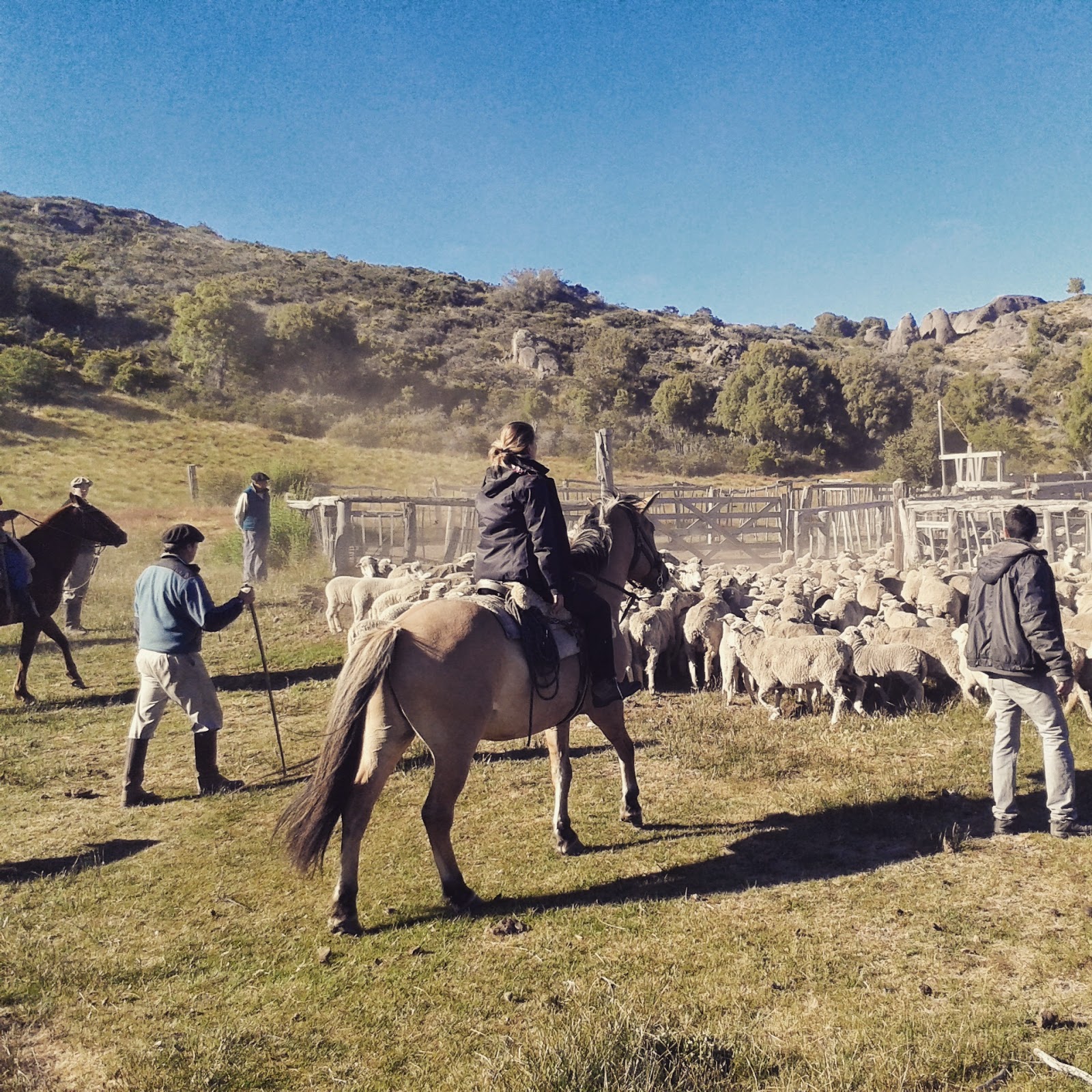Herding the sheep started out as a fun job. It seemed easier than rounding up horses. The woolly 'baa-ing' huddle bumbled across the pastures, while we walked calmly behind on horseback, encouraging them along with 'ayyyyy-ups' and calls of 'siga siga siga'. If one panicked or strayed from the group, a quick step in its direction usually sent it bouncing towards the flock, and if not, the dog would dart round behind sending it back the way it came in a rapid scramble.
The bridge over the river caused the first bottleneck. The sheep at the front ground to a halt, seemingly blind to the chorus of shouts behind, and those behind started to shift and swivel; a mutiny was brewing. Then, all of a sudden, instead of looking at a sea of white, woolly bottoms, I was confronted with 250 baa-ing faces. In one movement, the flock flowed through the gaps between our horses and flooded towards the pasture.
The subsequent successful crossing seemed to rely on momentum: keeping them moving but not rushing them into a panic, a technique that was key for the next jam, which formed at the gates of the coral. However stupid sheep are, I couldn't help but feel that the flock leaders were dithering with a sort of knowing reluctance, and what followed confirmed that their reticence had reason...
I knew the herd was being marked and separated for sale, but I wasn't exactly sure what that involved. The reality was brutal. Each sheep was lifted on to the fence, back legs pinned behind their ears and bottoms exposed; a knife cleanly sliced through the flesh of their tail, and a hole punch marked the ear (essential work to prevent disease apparently). The girls were then dropped in a scrambling heap on the floor, running away with a bloody stump dripping down their back legs. The boys however were kept bottom-up, as a gaucho put teeth to testicles and castrated them in one gruesome mouthful. A grizzly spectacle. By the end of the morning, a small pile of bloody balls had been spat out onto the fence post, just above a sad mound of limp tails.
As it turns out, those were the lucky ones. That afternoon, I was unwittingly roped in to help bundle the remaining sheep into a lorry and off to the slaughter house. Under orders, I clambered into the back of the truck, was given a sheep and told to grip its leg tightly while the men tried to press the rest of the flock in after me. More scared of the gruff gaucho than I was of the startled sheep, I did my best to cling on to it, but my heart soon gave way to its struggles; I let it slip free when the team looked away. My morale sank even lower when I was then given another, this time instructed to hang onto it by the neck. Desperate to let go of the poor writhing creature, as soon as another sheep was thrown into the truck, I released it and leapt over the side of the lorry.
The silver lining of the afternoon was that, just before the truck gate was closed, two little lambs somehow managed to bounce their way to freedom. Happily, attempts to round them up failed; I watched with a smile as they high-tailed it to happiness in the pasture - for another year at least!
The bridge over the river caused the first bottleneck. The sheep at the front ground to a halt, seemingly blind to the chorus of shouts behind, and those behind started to shift and swivel; a mutiny was brewing. Then, all of a sudden, instead of looking at a sea of white, woolly bottoms, I was confronted with 250 baa-ing faces. In one movement, the flock flowed through the gaps between our horses and flooded towards the pasture.
The subsequent successful crossing seemed to rely on momentum: keeping them moving but not rushing them into a panic, a technique that was key for the next jam, which formed at the gates of the coral. However stupid sheep are, I couldn't help but feel that the flock leaders were dithering with a sort of knowing reluctance, and what followed confirmed that their reticence had reason...
As it turns out, those were the lucky ones. That afternoon, I was unwittingly roped in to help bundle the remaining sheep into a lorry and off to the slaughter house. Under orders, I clambered into the back of the truck, was given a sheep and told to grip its leg tightly while the men tried to press the rest of the flock in after me. More scared of the gruff gaucho than I was of the startled sheep, I did my best to cling on to it, but my heart soon gave way to its struggles; I let it slip free when the team looked away. My morale sank even lower when I was then given another, this time instructed to hang onto it by the neck. Desperate to let go of the poor writhing creature, as soon as another sheep was thrown into the truck, I released it and leapt over the side of the lorry.

























